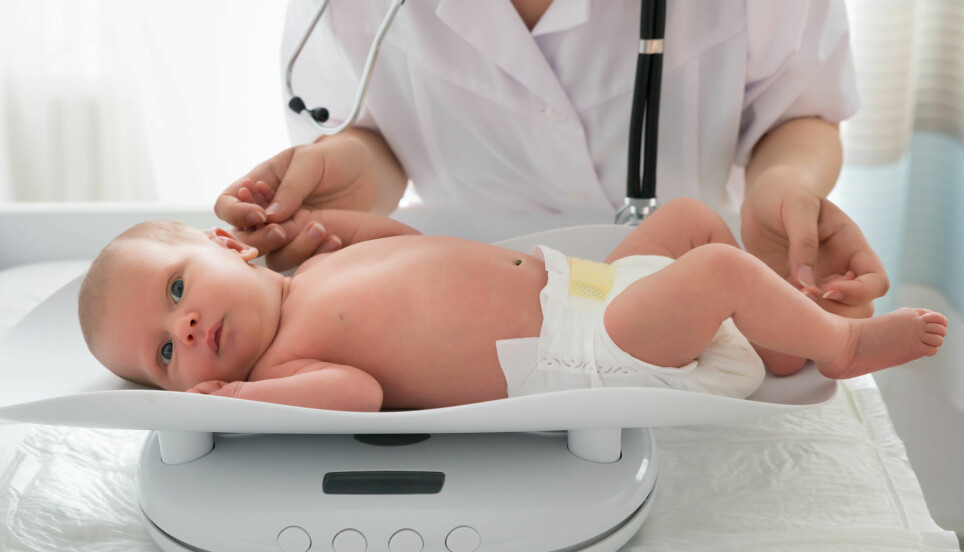
Babies conceived with assisted reproduction weigh less when they are born, but they rapidly catch up
When 17-year-olds who were conceived with assisted reproduction were screened before military service, they provided information about their height and weight. Researchers have used these data to find out how they have fared over time.
Around 3 out of 100 Norwegian children are conceived using assisted reproductive technologies.
Studies from a number of countries have shown that these children weigh less when they are born, on average, than those who are conceived naturally.
But what happens with these children as they grow and develop?
Researchers behind a new Norwegian study now have an answer to this question.
They identified about 1700 children conceived with assisted reproduction from the Norwegian Mother, Father and Child Cohort Study.
Since the children in this study have been followed over time, the researchers were able to collect information on their development from birth until they turned seven.
For the rest of the puzzle pieces, the researchers turned to the Norwegian Armed Forces Health Registry. But more about that later.
Rapid growth
Let’s begin at the beginning —or the children’s first years of life.
At birth, these babies weighed on average 113 grams less than other naturally conceived children.
But in a couple of years, they had not only taken the lead, but had grown a little heavier — and taller — than their peers.
“They grow very quickly in the first years of life and catch up with the naturally born children,” said Maria Christine Magnus at the Norwegian Institute of Public Health. Magnus was one of the researchers behind the new study.
By the time the children reached the age of 7, the differences were gone. The babies that were conceived through assisted reproduction were almost as large as the other children.
17-year-olds in military register
So what happened after the children turned seven?
The answer couldn’t be found in the Norwegian Mother, Father and Child Cohort Study — the children who are in the study were simply not old enough.
But the researchers realized they had another database to draw on: The Norwegian Armed Forces Health Registry.
When Norwegian teenagers are screened for military service, they have to fill out an online form, where they provide their height and weight.
4000 teenagers who were conceived with assisted reproduction technology
This information can be found in the Armed Forces' health registry. The researchers were able to identify 17-year-olds who were conceived using assisted reproductive technology.
Among more than 500,000 teenagers, more than 4,000 of them were babies conceived through assisted reproduction.
And when the researchers compared 17-year-old adolescents who were conceived with assisted reproduction with other teens of the same age, they found no differences in height and weight between the two groups.
Magnus believes this is good news for the children in question and their parents.
At the same time, she emphasizes that it is not possible to come to a firm conclusion yet. Whether their lower birth weight will affect the children as they grow older remains to be seen.
Low birth weight can be linked to health risks
Low birth weight babies can be at increased risk of different health problems.
For example, individuals who are small when they are born are more likely to be overweight as they get older, previous research has shown.
In addition, low birth weight individuals have a greater risk of developing cardiovascular disease. But it’s not yet clear that this is true for babies conceived through assisted reproduction.
“If they just catch up with their peers and follow a normal development pattern afterwards, that’s reassuring,” Magnus says.
Improve technology
So how should this information be used?
Magnus says the most important thing about studying how these babies grow and develop is that it gives researchers the opportunity to improve the technology.
For example, different methods can affect how children fare as they get older.
In the new study, the researchers show that there is a difference between whether the embryo has been frozen or not before it is inserted into the mother's womb.
Children conceived from frozen embryos weighed more when they were born than those conceived from fresh embryos.
Hormone therapy may be possible explanation
The researchers do not know why this is true, but Magnus offered one possible explanation.
“When a fresh embryo is inserted, the mother has recently undergone hormone treatment. Maybe the hormones affect the environment inside the uterus,” she says.
However, when a frozen embryo is inserted into the uterus, more time has passed since the woman was given hormone treatment.
Whatever the reason for the findings, researchers can’t conclude whether the different methods affect the children's health as they get older.
Couples who spent a long time having children also had smaller babies
At the same time, results from the new study indicate that it is not only assisted reproductive technology that affects babies’ weights.
The researchers were able to identify couples who had spent more than a year getting pregnant naturally.
More than 5,000 children were born to parents with lower fertility in the Norwegian Mother, Father and Child Cohort Study.
These children also had a lower birth weight, although it was not as low as the babies conceived through assisted reproduction.
This suggests that the fertility of the parents also affects the birth weight of the children, regardless of whether they have conceived using assisted reproductive technologies or not.
Translated by: Nancy Bazilchuk.
Read the Norwegian version of this article on forskning.no.
Reference:
Maria C. Magnus et al.: Growth in children conceived by ART, Human Reproduction Journal 2021, https://doi:10.1093/humrep/deab007
































